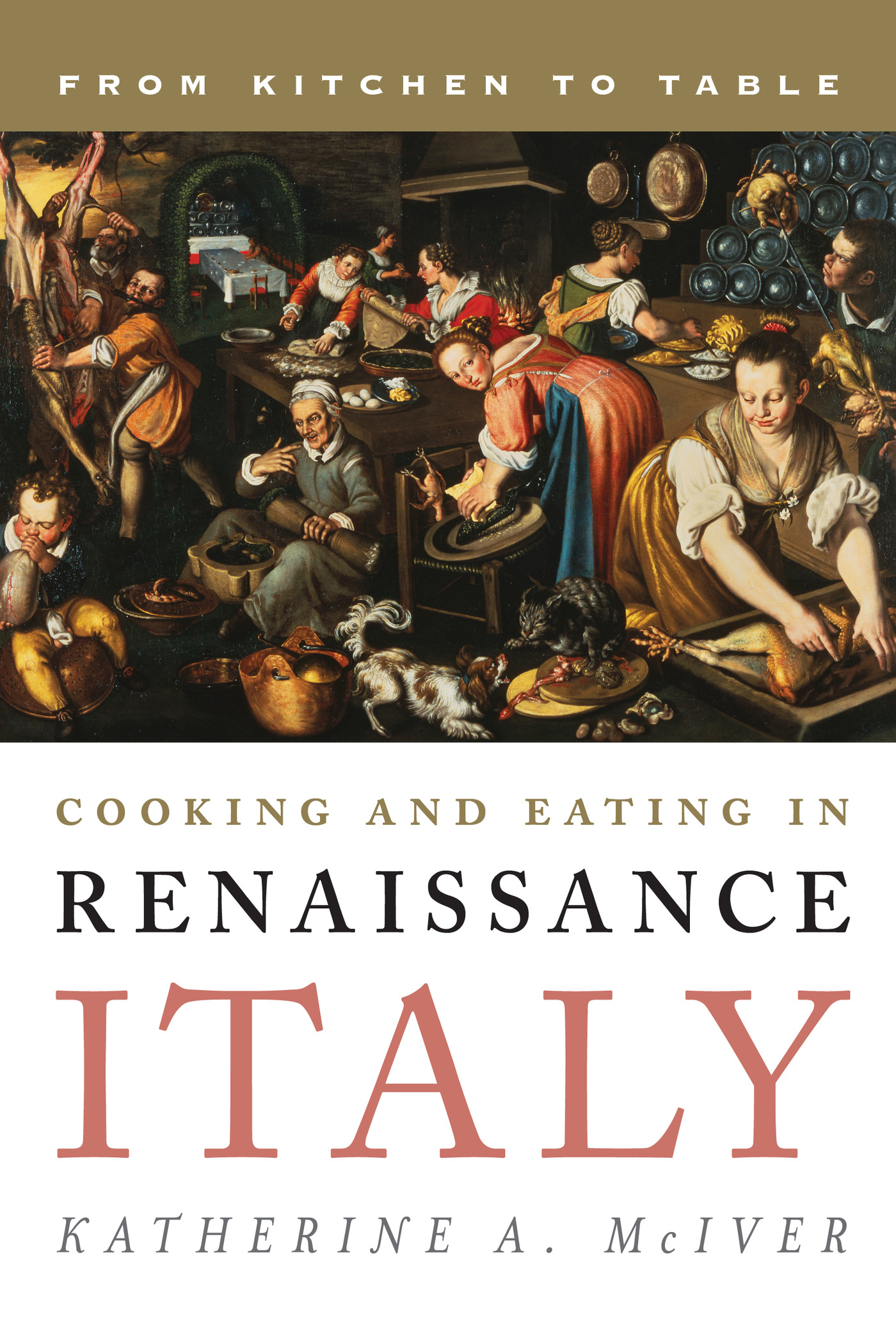Cooking and Eating in
Renaissance Italy
Rowman & Littlefield Studies in Food and Gastronomy
General Editor: Ken Albala, Professor of History, University of the Pacific
(kalbala@pacific.edu)
Food studies is a vibrant and thriving field encompassing not only cooking and eating habits but also issues such as health, sustainability, food safety, and animal rights. Scholars in disciplines as diverse as history, anthropology, sociology, literature, and the arts focus on food. The mission of Rowman & Littlefield Studies in Food and Gastronomy is to publish the best in food scholarship, harnessing the energy, ideas, and creativity of a wide array of food writers today. This broad line of food-related titles will range from food history, interdisciplinary food studies monographs, general interest series, and popular trade titles to textbooks for students and budding chefs, scholarly cookbooks, and reference works.
Titles in the Series
Appetites and Aspirations in Vietnam: Food and Drink in the Long Nineteenth Century, by Erica J. Peters
Three World Cuisines: Italian, Mexican, Chinese, by Ken Albala
Food and Social Media: You Are What You Tweet, by Signe Rousseau
Food and the Novel in Nineteenth-Century America, by Mark McWilliams
Man Bites Dog: Hot Dog Culture in America, by Bruce Kraig and Patty Carroll
New Orleans: A Food Biography, by Elizabeth M. Williams (Big City Food Biographies series)
A Year in Food and Beer: Recipes and Beer Pairings for Every Season, by Emily Baime and Darin Michaels
Breakfast: A History, by Heather Arndt Anderson (The Meals series)
Celebraciones Mexicanas: History, Traditions, and Recipes, by Andrea Lawson Gray and Adriana Almazn Lahl
Food History Almanac: Over 1,300 Years of World Culinary History, Culture, and Social Influence, by Janet Clarkson
The Food Section: Newspaper Women and the Culinary Community, by Kimberly Wilmot Voss
Small Batch: Pickles, Cheese, Chocolate, Spirits, and the Return of Artisanal Foods, by Suzanne Cope
Cooking and Eating in
Renaissance Italy
From Kitchen to Table
Katherine A. McIver
ROWMAN & LITTLEFIELD
Lanham Boulder New York London
Published by Rowman & Littlefield
A wholly owned subsidiary of The Rowman & Littlefield Publishing Group, Inc.
4501 Forbes Boulevard, Suite 200, Lanham, Maryland 20706
www.rowman.com
Unit A, Whitacre Mews, 26-34 Stannary Street, London SE11 4AB
Copyright 2015 by Rowman & Littlefield
All rights reserved. No part of this book may be reproduced in any form or by any electronic or mechanical means, including information storage and retrieval systems, without written permission from the publisher, except by a reviewer who may quote passages in a review.
British Library Cataloguing in Publication Information Available
Library of Congress Cataloging-in-Publication Data
Library of Congress Cataloging-in-Publication Data Is Available
ISBN 978-1-4422-2718-7 (cloth : alk. paper)
ISBN 978-1-4422-2719-4 (electronic)
 TM The paper used in this publication meets the minimum requirements of American National Standard for Information Sciences Permanence of Paper for Printed Library Materials, ANSI/NISO Z39.48-1992.
TM The paper used in this publication meets the minimum requirements of American National Standard for Information Sciences Permanence of Paper for Printed Library Materials, ANSI/NISO Z39.48-1992.
Printed in the United States of America
List of Figures
Acknowledgments
As with any project of this kind, one accrues many debts and it is now my pleasure to thank those who so generously contributed to its completion. First and foremost, I must thank Ken Albala. His enthusiasm for this project began during a discussion of my research during a casual meeting at the 2012 Cookbook Conference in New York City, and he asked me to write a book proposal for this series; his subsequent reading of the manuscript made what started out some years ago as an idea for an article and became instead this book. Equally important to this project is Barbara Ketcham Wheaton whom I met during her Reading Historical Cookbooks afternoon seminar at the same conference where I met Ken; this was followed by her week-long workshop on the same topic. This experience helped to shape the format of this book; the tools I learned from Barbara are indispensable, as is her friendship, encouragement, and support. There are those who shared archival documents: Maria Maurer, Joyce de Vries, and Catherine Fletcher, which certainly added breadth to the book. Conversations with Alison Smith helped me to formulate my ideas. As well, I need to thank Liz Kurtulik-Mercuri and Peter Rohowsky at Art Resource for chasing down an engraving of sugar sculptures that eluded me. And of course, my editor, Suzanne Staszak-Silva deserves mention for her patience and understanding as deadlines slipped by, for her reading of early drafts of three chapters, which changed how I viewed the book, and for an encouraging phone conversation. Her assistant, Kathryn Knigge, was instrumental in helping me with the images for this book, among other things, and has been a delight to work with. Finally, I which to thank my husband, William C. McIver, and many friends, who listened patiently, kept me focused, and offered never-ending support throughout the process.
Chapter 1
The Renaissance Kitchen and the Experience of Dining
An Introduction
This is the story of cooking and eating. It is about the experience of dining and the orchestration of a meal in Renaissance Italy. Well move from the kitchen, to the acquisition of goods, to food preparation and final presentation at the table, both in the city residence and the country estate. It is about how, what, and where people ate and what went into the preparation of a meal. We will look at the cast of characters who made it all happenincluding the cook, the steward, and all those involved in creating and serving a mealand explore just what their duties were. It was the steward, for example, who oversaw everything that happened in the kitchen including ordering supplies and creating the menu and controlling exactly how the meal was served; the head cook was the main figure in the kitchen, and he was in charge of his team of at least one undercook, helpers, and apprentices. Well examine letters, like those of Isabella dEste (14741539), marchesa of Mantua; a prolific letter writer, she had a keen interest in food, acquiring recipes for favorite dishes, and seeking to hire the perfect cook. Well use household inventories, like those of Laura Pallavicina-Sanvitale (ca. 14951576) of Parma, to walk through the homes of the middle and upper classes to see their kitchens, pantries, wine cellars, and dining spaces and how they were stocked. Well read culinary treatises and contemporary cookbooks, like those of Cristoforo da Messisbugo, chief steward at the court of Ferrara in the early sixteenth century, and Bartolomeo Scappi, master cook for Pope Pius V in mid-sixteenth-century Rome. These books provide us with details about menus, meal planning, and specific meals and staffing. Well look at specific events, like the banquets hosted by such dignitaries as Cardinal Pietro Riario in Rome (1473), and well see just how these grand meals were orchestrated, from planning the menu to decorating the tables and serving the many courses.
Our story begins in the late-medieval kitchen, dating from the late fourteenth to the early fifteenth century (chapter 2), then turns its focus to the Renaissance, the late fifteenth through the sixteenth century (chapters 3, 4, and 5), and ends in the 1660s (chapter 6); the later seventeenth century and the eighteenth century witnessed many decisive changes in the evolution of cooking and are not part of our story. According to Alberti, then, these artists were the foundation of the Renaissance.

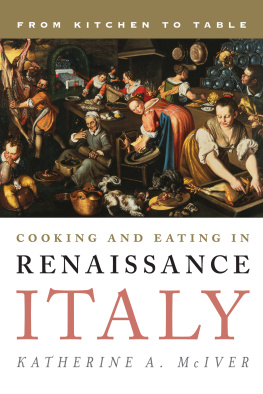
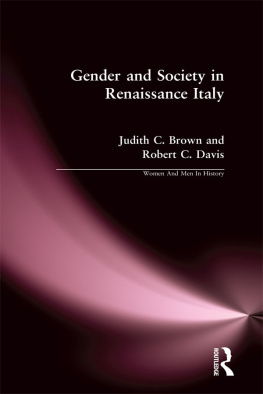
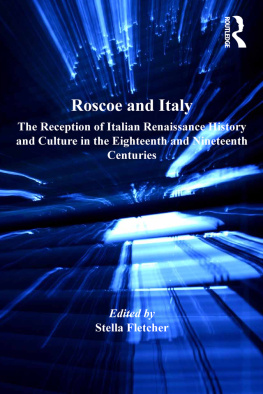



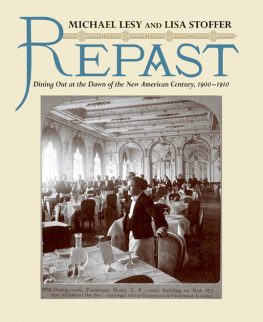

 TM The paper used in this publication meets the minimum requirements of American National Standard for Information Sciences Permanence of Paper for Printed Library Materials, ANSI/NISO Z39.48-1992.
TM The paper used in this publication meets the minimum requirements of American National Standard for Information Sciences Permanence of Paper for Printed Library Materials, ANSI/NISO Z39.48-1992.